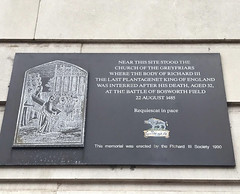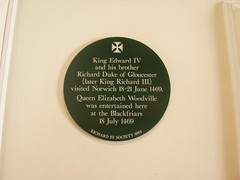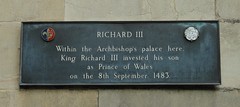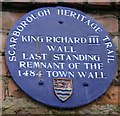King Richard III of England


King Richard III of England
(1452-1485)
Plantagenet and King of England (1483-1485)
Family tree
- Duke Richard of York (1411-1460) Duke of York Cecily Neville (1415-1495)
Commemorated on 13 plaques
Near this site stood the Church Of The Greyfriars where the body of Richard III the last Plantagenet King of England was interred after his death aged 32, at the Battle of Bosworth Field 22 AUGUST 1485 ... Requiescat in pace
Grey Friars, Leicester, United Kingdom where they was interred
King Edward IV and his brother Richard Duke of Gloucester (later King Richard III) visited Norwich 18-21 June 1469. Queen Elizabeth Woodville was entertained here at the Blackfriars 18 July 1469
Blackfriars Hall, Norwich, United Kingdom where they visited (1469)
King Richard III 1483-1485 is reputed to have stayed here
23-24 Sandside, Scarborough, United Kingdom where they reputedly stayed
Richard III. Within the Archbishop's palace here, King Richard III invested his son as Prince of Wales on the 8th September, 1483.
Dean's Park, York, United Kingdom where they invested his son (1482)
Crosby Hall originally stood in Bishopsgate in the City of London and was transferred to this site under threat of demolition in 1910. It formed part of Crosby Place built in th 15th century for Sir John Crosby, a wealthy wool merchant, and after him was occupied by King Richard III. It later passed to Sir Thomas More on whose estate in Chelsea it has come to rest.
Cheyne Walk, Chelsea, SW3, London, United Kingdom where they occupied
According to tradition the residence C.1471 of Richard Duke of Gloucester King Richard III 1483 - 85
Great Dockwray, Penrith, United Kingdom where they lived
Richard III, as Duke of Gloucester and later King of England, was Lord of Barnard Castle from c.1474 until his death in 1485. He made improvements to the castle, took a close interest in the town and was a great benefactor of its church.
1 Newgate, Barnard Castle, United Kingdom where they mentioned (1473-1484)
King Richard III wall last standing remnant of the 1484 town wall
North Terrace car park boundary wall, Scarborough, United Kingdom where they is commemorated
Richard, the last Plantagenet King of England, was slain here 22nd August 1485
Richard's Field, Northwest of Ambion Hill, Sutton Cheney, United Kingdom where they was killed (1485)
Near this spot, on August 22nd 1485, at the age of 32, King Richard III fell fighting gallantly in defence of his realm & his crown against the usurper Henry Tudor. The Cairn was erected by Dr. Samuel Parr in 1813 to mark the well from which the king is said to have drunk during the battle. It is maintained by the Fellowship of the White Boar.
Richard's Well, Northwest of Ambion Hill, Sutton Cheney, United Kingdom where they was killed near (1485)
Returning from exile on Tuesday 12 March 1471 King Edward IV and his brother Richard Duke of Gloucester (Richard III) made their first landfall at Cromer
The Esplanade, Cromer, United Kingdom where they landed (1471)
On this site stood the Royal Hunting Lodge of Beskwood. It was while staying here in August 1485 that King Richard III learned of Henry Tudor's invasion
Bestwood Lodge, Nottingham, United Kingdom where they was (1484)
The Angel Inn. A gatehouse Inn dating from the 15th century. King Richard III received the Great Seal here 1483. Other monarchs stayed here. The inn was renamed The Angel and Royal in 1866.
4-5 High Street, Grantham, United Kingdom where they visited (1482)













